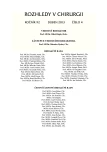Mediastinitis after esophageal perforation
Authors:
J. Šafránek; J. Geiger; J. Klečka; T. Skalický; V. Špidlen; V. Veselý; J. Vodička
Authors‘ workplace:
Chirurgická klinika FN Plzeň, přednosta: prof. MUDr. V. Třeška, DrSc.
Published in:
Rozhl. Chir., 2013, roč. 92, č. 4, s. 195-200.
Category:
Original articles
Práce je věnována významnému životnímu jubileu prof. MUDr. Jiřího Valenty, DrSc.
Overview
Introduction:
Assessment of therapy in patients with mediastinal infection resulting from esophageal perforation.
Material and methods:
Retrospective (2008–2012) processing of a group of surgically treated patients. The aspects assessed were aetiology, the surgical methods applied and the length of therapy.
Results:
The total number of patients treated was 16. In 8 cases, the aetiology was iatrogenic (3 cases of leaking esophageal anastomosis in consequence of resection of the esophagus, 2 cases of perforation after fundoplication, 1 case of esophageal cardiomyotomy, and 2 cases of perforation during endoscopy). In 4 patients, the aetiology was spontaneous perforation, impacted foreign bodies caused difficulties to 3 patients, and the last cause was acid corrosive esophagitis. A stent was applied in all the patients at the site of the defect. The mediastinitis was drained through the access from thoracotomy or left thoracolaparotomy, respectively (8 cases), or by combination of laparotomy/laparostomy and pleural drainage (5 cases). Pleural (in 3 cases) and neck (1 case) drainage meant minimum intervention. Esophagectomy was not carried out in any of the patients. 4 patients died. The average period of time for which the stent was left in situ was 53.7 days; the average time of hospitalization in surviving patients was 53.4 days.
Conclusion:
Stent application does not show any difference regarding patients’ survival (25% mortality), but enables shortening the total therapy time and, predominantly, preserving the native esophagus.
Key words:
mediastinitis – esophageal perforation
Sources
1. Brinster CJ, Singhal S, Lee L, Marshall MB, Kaiser LR, Kucharczuk JC. Evolving options in the management of esophageal perforation. Ann Thorac Surg 2004;77,4:1475–1483.
2. Mai C, Nagel M, Saeger HD. Surgical therapy of esophageal perforation. A determination of current status based on 4 personal cases and the literature. Chirurg 1997;68:389–394.
3. Campos GM, Vittinghoff E, Rabl C, Takata M, Gadenstatter M, Lin F, et al. Endoscopic and surgical treatments for achalasia: a systematic review and meta-analysis. Ann Surg 2009;249, 1:45–57.
4. Foley MJ, Ghahremani GG, Rogers LF. Reappraisal of contrast media used to detect upper gastrointestinal perforations: comparison of ionic water-soluble media with barium sulfate. Radiology 1982;144:231–237.
5. Castelguidone E, Merola S, Pinto A, Raissaki M, Gagliardi N, Romano L. Esophageal injuries: spectrum of multidetector row CT findings. Eur J Radiol 2006;59,3:344–348.
6. Cameron JL, Kiefer RF, Hendrix TR, et al. Selective nonoperative management of contained intrathoracic disruptions. Ann Thorac Surg 1979;27:404–408.
7. Altorjay A, Kiss J, Voros A, Bohak A. Nonoperative management of esophageal perforations. Is it justified? Ann Surg 1997;225, 4:415–421.
8. Minnich DJ, Yu P, Bryant AS, Jarrar D, Cerfolio RJ. Management of thoracic esophageal perforations. Eur J Cardiothorac Surg 2011;40,4:931–937.
9. Shields TW. Esophageal Trauma. In: Shields TW, Licicero III J, Reed CE, Feins RH: General thoracic surgery. 7th edition. Philadelphia, Lippincott Williams & Wilkins 2009:2101–2120.
10. Whyte RI, Iannettoni MD, Orringer MB. Intrathoracic esophageal perforation: the merit of primary repair. J Thorac Cardiovasc Surg 1995;109:140–146.
11. Grillo HC, Wilkins Jr EW. Esophageal repair following late diagnosis of intrathoracic perforation. Ann Thorac Surg 1975;20,4:387–99.
12. Geiger J, Šebor J, Veselý V. Jícnové stenty. Rozhl Chir 2004; 83,11:554–558.
13. Salminen P, Gullichsen R, Laine S. Use of self-expandable metal stents for the treatment of esophageal perforations and anastomotic leaks. Surg Endosc 2009;23,7:1526–1530.
14. Fischer A, Thomusch O, Benz S, Dobschuetz E, Baier P, Hopt UT. Nonoperative treatment of 15 benign esophageal perforations with self-expandable covered metal stents. Ann Thorac Surg 2006; 81,2:467–472.
15. Gelbmann CM, Ratiu NL, Rath HC, Rogler G, Lock G, Scholmerich J, et al. Use of sef-expandable plastic stents for the treatment of esophageal perforations and symtomatic anastomotic leaks. Endoscopy 2004;36,8:695–699.
16. Morgan RA, Ellul JP, Denton ER, Glynos M, Mason RC, Adam A. Malignant esophageal fistulas and perforations: management with plastic-covered metallic endoprotheses. Radiology 1997; 204,2:527–532.
17. Cameron JL, Kieffer RF, Hendrix TR, Mehigan DG, Baker RR. Selective nonoperative management of contained intrathoracic esophageal disruptions. Ann Thorac Surg 1979;27:404–408.
18. Vogel SB, Rout WR, Martin TD, Abbitt PL. Esophageal perforation in adults. Aggressive conservative treatment lowers morbidity and mortality. Ann Surg 2005;241:1016–1023.
19. Wright CD, Mathisen DJ, Wain JC, Moncure AC, Hilgenberg AD, Grillo HC. Reinforced primary repair of thoracic esophageal perforation. Ann Thorac Surg 1995;60:245–249.
20. Wang N, Razzouk AJ, Safavi A, Gan K, Van Arsdell GS, Burton PM, Fandrich BL, Wood MJ, Hill AC, Vyhmeister EE, Miranda R, Ahn C, Gundry SR. Delayed primary repair of intrathoracic esophageal perforation: is it safe? J Thorac Cardiovasc Surg 1996;111:114–122.
21. Richardson JD. Management of esophageal perforations: the value of aggressive treatment. Am J Surg 2005;190:161–165.
22. Salo JA, Isolauri JO, Heikkila LJ, Markkula HT, Heikkinen LO, Kivilaakso EK, Mattila SP. Management of delayed esophageal perforation with mediastinal sepsis. J Thorac Cardiovasc Surg 1993;106,6:1088–1091.
23. Šafránek J, Špidlen V, Skalický T, Vodička J, Martínek J, Andrle P. Descendentní nekrotizující mediastitinitida – chirurgická léčba. Rozhl Chir 2012;91,7:362–367.
24. Pazdro A, Haruštiak T, Šnajdauf M, Smejkal M, Schützner J, Pafko P, Tvrdoň J, Lischke R. Perforace jícnu. Rozhl Chir 2011;90,11:647–652.
25. Bohanes T, Neoral Č. Akutní mediastinitida. Rozhl Chir 2011;90,11:604–611.
Labels
Surgery Orthopaedics Trauma surgeryArticle was published in
Perspectives in Surgery

2013 Issue 4
Most read in this issue
- Leriche’s syndrome
- Abdominal compartment syndrome – review of current knowledge, diagnosis and management
- Double gallbladder – a rare congenital variation
- Mediastinitis after esophageal perforation
